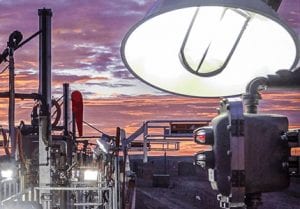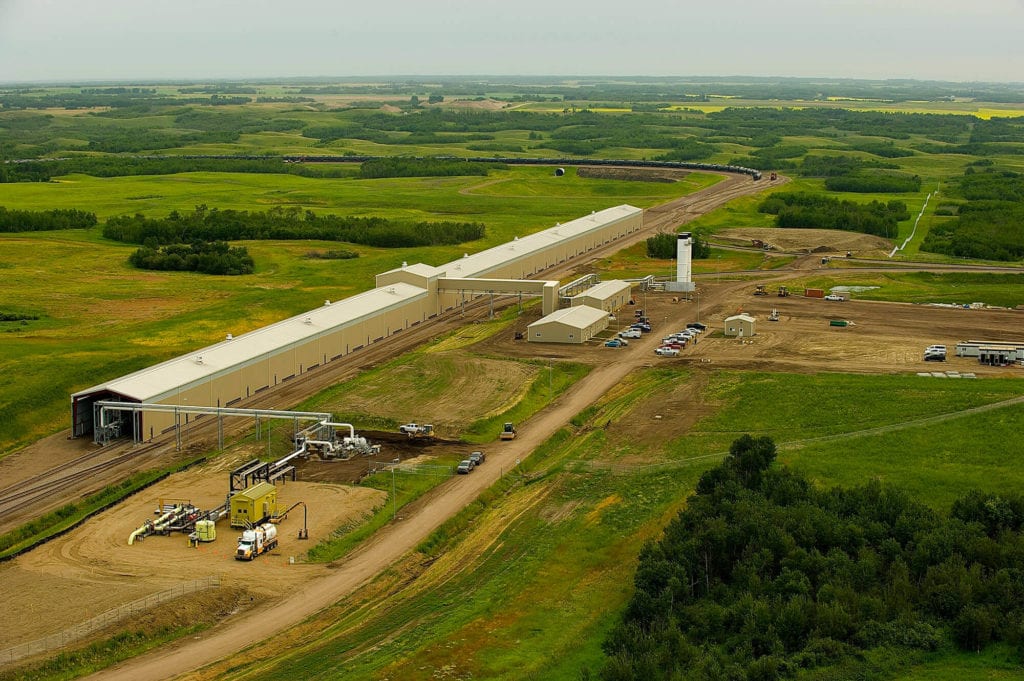Get a quote, configure a custom safety solution or ask a question. We're here to help!








- Spill ContainmentMore …Loading Safety CagesMore …
SafeRack Worldwide
We pride ourselves on one-on-one customer service. When you call SafeRack, we'll be there to answer your questions with a combined experience of 400+ years.
Select your region below.- View Products
- Railcar & Truck Loading Platforms
- Gangways & Loading Ramps
- Stairs, Platforms & Ladders
- Mobile Ladders & Platforms
- Loading Arms & Fluid Transfer
- Safety Gates & Traffic Control
- Aviation & Aerospace Access
- Marine Access & Loading
- Grounding & Monitoring
- Spill Containment
- Loading Safety Cages
- Transloaders & Skids
- Shelters & Canopies
- Fall Protection
- Terminal & Speciality
Home / Industries / Bulk Chemical Loading / Green Liquor (Spent Pulping Liquor) HandlingGreen Liquor (Spent Pulping Liquor) Handling Design, Loading, and Installation.
Although no two Green Liquor Loading solutions will be identical, the product itself determines much of the critical design criteria that will ensure that optimum safety and productivity can work together in harmony.
Green Liquor is an important by-product recovered from the kraft pulping of resinous woods in paper mills. It is the dissolved smelt of sodium carbonate, sodium sulfide, and other compounds from the recovery boiler in the kraft process. The liquor’s green color derives from the presence of colloidal iron sulfide. Green liquor is usually reacted with lime (CaO) in the causticizing stage to regenerate white liquor.








Question, Get a Quote, Live Demo or Request an On-Site Visit
Our experts simplify the complex
View Full TextIn the United States, Green liquor is a “tight-fill” (closed-loop) loading operation and is top loaded into rail cars via chemical hoses or 3” stainless steel loading arms. Green liquor, if not handled properly can cause burns and Personal Protective Equipment (PPE) is required. Additionally, because operators are on top of the vehicles during the loading process, robust, well-designed fall prevention is essential to ensure increased throughput, without compromising operator safety.
Green liquor is typically shipped in 26,000 gallon DOT-111 insulated or non-insulated tank cars with safety valves that meet the DOT specification for the transportation of green liquor and other similar commodities. The rails cars themselves are ~ 9′ outside diameter with an overall length of ~45’ to 50′, with a 6’ x 6’ center opening or off-set crash box openings.
Tank truck (un)loading procedures are similar to railcar applications with the trailers meeting established DOT requirements for transporting green liquor. Approved DOT trailers include MC 307 or low pressure chemical ISO containers. Trailers and ISO’s are typically bottom unloaded. An extension pipe with two valves is flanged to the top of the trailer.
All trailers must be equipped with pressure relief valves; and trailers with bottom outlets must be equipped with remote controlled stop valves.
Typical Green Liquor Loading Platform
Quote or discuss your installation.
Start by selecting loading application"*" indicates required fields
Below are some of the loading and unloading solutions for illustrative purposes only. Our experts will work with you and your team for a custom solution to suit your needs.
Green Liquor Loading Arms
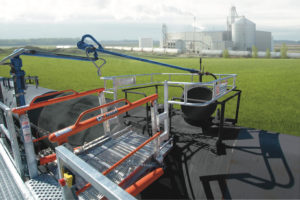
Green Liquor is typically loaded into railcars or tank trucks via boom supported stainless steel loading arms or chemical hoses with a flange connection. The arm or hose will have a top inlet with a control valve to ensure that it is self-draining after use and is supported along the length of a mechanical loading arm to improve handling; this is known as a by-pass arm. You can install one liquid and one vapor arm, or mount both the liquid and vapor hoses on one by-pass arm. For unloading, typically you would use a rigid stainless steel self-draining loading arm with Nitrile, PTFE or Viton seals, Purge lines can be fitted to the arm, for nitrogen purging. Additional features such as parking latches with proximity sensors can be incorporated into the total system to ensure the arm is correctly stowed when not in use, before any rail movement can occur.
For unloading, green liquor is typically bottom unloaded via a rigid stainless steel, self-draining arm or 20’ flex hose with flanged ends or dry disconnect fittings.
Loading Gangways and Safety Cages


A wider access gangway (48″-60″ is preferable) as it helps improve access and egress to and from the vessel. In addition, a wider gangway will reduce the risk of the operator’s PPE getting caught, torn or damaged, and will improve productivity and safety. Powered gangway solutions are also an option, with both hydraulic and pneumatic solutions being commonly used. Each gangway will be fitted with a two-rail safety cage for the railcar crash box. This will be a centered 6’x6’ safety cage to sit directly over the cashbox. This will provide a safe, secure work environment for your operator when connected to their breathing apparatus
GX FLAT RAMP ACCESS (FRT) GANGWAY
SafeRack’s NEW GX-FRT is a flat ramp model popular with railcars. It features a slip-resistant walk surface and, with the use of the telescoping extension, eliminates gaps on narrow railcars. Learn More
Green Liquor Eye Wash/Drench Showers

ANSI guidelines state that an Eye Wash/Drench Showers need to be located 10 seconds or 55’ (16.8m) from contaminants or hazardous materials. Eyewash stations need to be on the same horizontal plane with no obstructions.
Therefore, we would propose the installation of a standard combination Drench Shower/Eyewash Unit, which will save limited space and fit easily into any work environment.
Green Liquor Spill Containment

Spill containment pans will be provided at the point of loading operations and is an essential piece of equipment in overall site safety and environmental protection Green Liquor Grounding

Black Liquor is not normally combustible. However risk of fire does exist in the presence of TRS gases. These fumes are flammable and can be ignited by heat or flame. Vapors have been known to travel back to ignition sources and flashback. - Vehicle grounding and bonding — ensure true grounding before product flow is permitted
- Explosion-proof enclosures — meet or exceed UL, CSA, and Ex requirements
- Non-sparking tools are also recommended while working around this product
Green Liquor Safety Gates

Safety Gates will be installed at the top of stairs and any other openings to ensure operator safety at all times.  YellowGate Safety Gates
YellowGate Safety GatesSafeRack’s line of industrial safety gates is the most flexible product on the market with the ability span openings between 16” and 36” and is field adjustable with nothing more than a wrench. Learn More
Green Liquor Options

- Lighting – Lighting both over and under the platform will be provided. For overcast days or second shift, lighting is essential for improved safety and improved productivity.
- Platform & Canopies – Full platform canopies reduce exposure to the elements and improve the safe and productive loading operation from the operator’s perspective.
- Operator Shelter – Depending on your site requirements, consideration should be given to the requirement of an operator or guard building on the loading platform. This can be customized to meet specific site requirements
- Wheel Chocks – Railcar Wheel Chocks provide fast blocking of all types of railcars and meet OSHA regulations to safely prevent railroad cars from moving during loading or unloading operations. This is a requirement by the Department of Homeland Security
Personal Protective Equipment PPE Requirements
Eye/Face Protection: Wear chemical safety goggles. A face shield (with safety goggles) may also be necessary.
Skin Protection: Wear chemical protective clothing e.g. gloves, aprons, boots. Coveralls or long sleeve shirts and pants in some operations. Wear a chemical protective, full-body encapsulating suit, and self-contained breathing apparatus (SCBA). Suitable materials include: butyl rubber, neoprene rubber, Viton®, Viton®/butyl rubber, Barrier® – PE/PA/PE, Silver Shield® – PE/EVAL/PE, Trellchem® HPS, Trellchem® VPS, Saranex®™, Tychem® BR/LV, Tychem® Responder® CSM, Tychem® TK. The following materials should NOT be used: natural rubber, polyvinyl chloride. Recommendations are NOT valid for very thin neoprene rubber gloves (0.3 mm or less).
Respiratory Protection: Up to 5 ppm:
(APF = 10) Any chemical cartridge respirator with cartridge(s) providing protection against chlorine*; or Any supplied-air respirator*.
*Reported to cause eye irritation or damage; may require eye protection.
APF = Assigned Protection Factor
Recommendations apply only to National Institute for Occupational Safety and Health (NIOSH) approved respirators. Refer to the NIOSH pocket guide to chemical hazards for more information.
Use a local exhaust ventilation and enclosure, if necessary, to control the amount in the air. Consider using a corrosion-resistant exhaust ventilation system separate from other ventilation systems. It may be necessary to use stringent control measures such as process enclosure to prevent product release into the workplace. Use backup controls (e.g. double mechanical pump seals) to prevent the release of this material due to equipment failure. * For illustrative purposes only. Our experts will work with you and your team for a custom solution to suit your needs Customer Reviews
 5 5I needed the product fast, and they delivered.
5 5I needed the product fast, and they delivered.I needed the product fast, and they delivered. The features I liked the most were the customer service, computer design, and expedited shipping.
By Michael Wilson from Hometown Pharmacy Partnerships on 5/17/16 5 5Every aspect of this purchase has been positive.
5 5Every aspect of this purchase has been positive.We purchased an identical one 2 months ago so we already knew exactly what we were getting… SafeRack’s product is built sturdier and it’s easier to use. It was delivered in under two weeks, every aspect of this purchase has been positive.
By James Dobson from Polychemie Inc. on 5/9/12 5 5Quality, functionality of the system and diversity.
5 5Quality, functionality of the system and diversity.We would recommend this solution because of the quality, functionality of the system and their diversity.
By Marc from Landmark Corp. on 3/10/15 5 5We are really happy with the unit and ordered a second one.
5 5We are really happy with the unit and ordered a second one.So far, we are really happy with the unit and ordered a second one. The drivers feel confident when they are grounded. Dana Hamor was very responsive – even considering the time zone change.
By Vern Bose from Mac & Mac Hydrodemolition Inc. on 1/30/12 4 5Better than the competitor’s product.
4 5Better than the competitor’s product.We like the product and have had very few problems with regards to maintenance. The platforms and gangways look better than the competitor’s product. The coating is very thick and we have not seen any rusting even on our older installation. Charles MacEachern has a great way of dealing with customers – his communication skills are very good and he is there for the customer when needed.
By Len Trevena from Bayer Crop Science on 2/9/11 5 5Everyone in the SafeRack group was great to work with.
5 5Everyone in the SafeRack group was great to work with.I placed this order as a replacement to our damaged equipment. We already knew the benefits of SafeRack loading platforms. We have had one since 2009. We just needed a couple replacement parts.
By Josh Kermes from Poet Biorefining Glenville on 11/2/16Green Liquor 101
Things to know about Green Liquor
Green Liquor is regulated by the U.S. Department of Transportation (DOT) and is classified as a hazardous caustic alkali liquid with the DOT identification number UN 1719.
Spent cooking liquor (black liquor) is mixed with sodium sulphate (salt cake) and then heated to lower its viscosity and then pumped into the recovery furnace. The intense heat in the furnace fuses in inorganic elements of the black liquor to form smelt. The smelt is then harvested from the furnace into a dissolving tank where it is mixed with water to form “green liquor”. Carbon and other impurities in the green liquor are settled out in a clarifier, filtered and sent to a landfill. The clarified green liquor is then subjected to a causticizing treatment with hot lime, Ca(OH)2 to convert sodium carbonate into sodium hydroxide. The resulting sodium hydroxide and sodium sulphide, now called “white liquor” is reused as cooking liquor for the wood chips.
Green liquor can cause severe skin burns, eye and lung damage. As any caustic liquid, exposure to green liquor can cause coagulative necrosis that can lead to extensive tissue damage, as well as, damage to the respiratory system if mists or vapors are inhaled.
Caustic Kraft process liquors, under certain conditions, can produce toxic sulfur gases that include hydrogen sulfide, methyl mercaptan, dimethyl sulfide and dimethyl disulfide. These gases are hazardous and their concentration will vary depending on whether the liquor is a strong or weak liquor. Regardless of the concentration, extreme care should be taken while working around these chemicals.
Only properly trained and equipped personnel should be permitted to (un)load turpentine tank cars and tank trucks. Operators should wear approved PPE equipment including impervious clothing, footwear, gloves, splash resistant goggles and a respirator.
First aid measures for exposure include – removing operators from the source of exposure and into fresh air. Remove contaminated clothing immediately; wash skin thoroughly with soap and water; flush eyes with tepid water for 15 minutes. If ingested do not induce vomiting, but immediately call your local poison control center. Aspiration into the lungs can cause fatal chemical pneumonitis. If ingestion has occurred, assume there is a risk of aspiration into the lungs.

Is your plant or facility compliant with ANSI, OSHA, and local safety codes? We can help!


EMERGENCY EYEWASHES / SHOWER EQUIPMENT AND THE ANSI/ISEA Z358.1 – 2014 STANDARD
Following eye contact, you must start washing with water immediately to prevent permanent damage. In the event of skin contact, you must start washing with water immediately to prevent slow-healing chemical burns.
Are you aware that ANSI guidelines state that Eye Wash/Drench Showers need to be located 10 seconds or 55′ from contaminates or hazardous materials and located on the same horizontal plane, with no obstructions? If bottom loading/unloading, an additional shower should be located at grade as well. SafeRack provides the above equipment plus much more needed to keep employees safe and expedite bulk chemical loading and unloading.
OSHA Regulation Experts – Does your existing chemical safety equipment or chemical loading systems meet OSHA’s latest requirements? SafeRack’s professional technical sales consultants are available to meet with your team to make recommendations to keep your facility in front of OSHA’s ever-changing country and region-specific standards and regulations, including lifeline and trolley beam fall arrest systems, metal stairs, and access platforms.
Installation Gallery
Why SafeRack?
The SafeRack approach is a collaborative one. Let’s call it The SafeRack Way. We have, over many years amassed a great deal of experience and understanding of the safety aspects involved in loading road tankers and railcars, as well as the behavioral habits of the operators.

Experts In Chemical Loading
- Acetic Acid
- Acetic Anhydride
- Acetonitrile
- Acrolein
- Acrylic Acid
- Acrylonitrile
- Aluminum Chloride
- Aluminum Sulfate
- Ammonia
- Ammonium Hydroxide
- Ammonium Nitrate
- Aniline
- Benzene
- Benzyl Chloride
- Bromotrifluoromethane
- Butadiene
- Carbon Dioxide
- Caustic
- Chlorine
- Chloroform
- Chlorosulfonic Acid
- DEF (Diesel Exhaust Fluid)
- Diethylene Glycol
- Dimethylformamide
- Dodecylbenzene Sulfonic Acid
- Ethanol
- Ethyl Acetate
- Ethyl Chloride
- Ethylene
- Ethylene Dichloride
- Ethylene Glycol
- Ethylene Oxide
- Ferric Chloride
- Ferrous Chloride
- Hexane
- Hydrochloric Acid
- Hydrofluoric Acid
- Hydrofluorosilicic Acid
- Hydrogen Cyanide
- Hydrogen Peroxide
- Hydrofluoric Acid
- Hypochlorous Acid
- Isopropyl Acetate
- Liquid Argon
- Liquid Nitrogen
- Liquid Oxygen
- Maleic Anhydride
- MDI
- Methanol
- Methyl Chloride
- Methyl Ethyl Ketone
- Methyl Methacrylate
- Methyl Isocyanate
- Molten Sulphur
- Nitric Acid
- Oleum
- Phenol
- Phosphoric Acid
- Phosphorus Oxychloride
- Phosphorus Trichloride
- Polypropylene
- Renewable Diesel
- Sodium Cyanide
- Sodium Hydroxide
- Sodium Hypochlorite
- Styrene Monomer
- Sulfuric Acid
- Sulfur Dioxide
- Titanium Tetrachloride
- Toluene
- Toluene Diisocyanate
- Turpenitne
- UAN (Urea Ammonium Nitrate)
- UREA
- Vinyl Acetate
- Vinyl Chloride
- Xylene
- Zinc Chloride
- Agro-Chemical
- Specialty Chemical
- Petrochemical

North America’s largest loading terminal
World-leading designer, manufacturer, and installer of truck and railcar loading platforms
As one of the primary railcar loading points, Hardisty is one of the major crude oil hubs in North America and a major origination point of pipelines that export to the United States. SCS was asked to supply and construct a SafeRack crude oil loadout terminal spanning nearly half a mile. The USD Hardisty terminal can load up to two 120-railcar unit trains per day and consists of a fixed loading rack with 62 railcar loading positions enclosed, separate control, operator, and mechanical buildings, as well as a unit train staging area and loop tracks capable of holding multiple unit trains simultaneously. SCS also supplied and installed boom-supported loading arms with supply and vapor management systems.

Quick Quote 866-761-7225
LET US DESIGN YOUR SOLUTION TODAY
Our innovative tools provide 3D visualizations and accurate quotes in minutes.
Get Help NowOrder Now 866-761-7225
Questions or Need a Quote?
Chat live with a knowledgeable and friendly safety expert now.

Bob Kashtan
Located in South Carolina

Joey Robinson
Located in South Carolina

Caelin Lacy
Located in South Carolina

Katie Kelly
Located in South Carolina

Amber Graham
Located in South Carolina













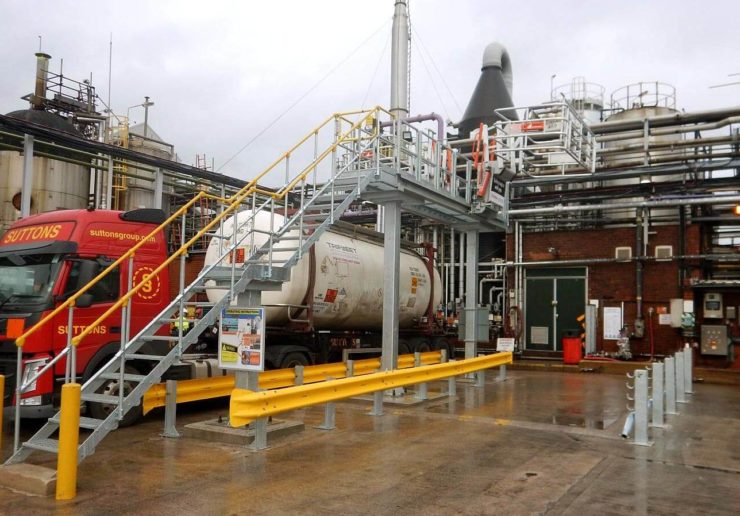
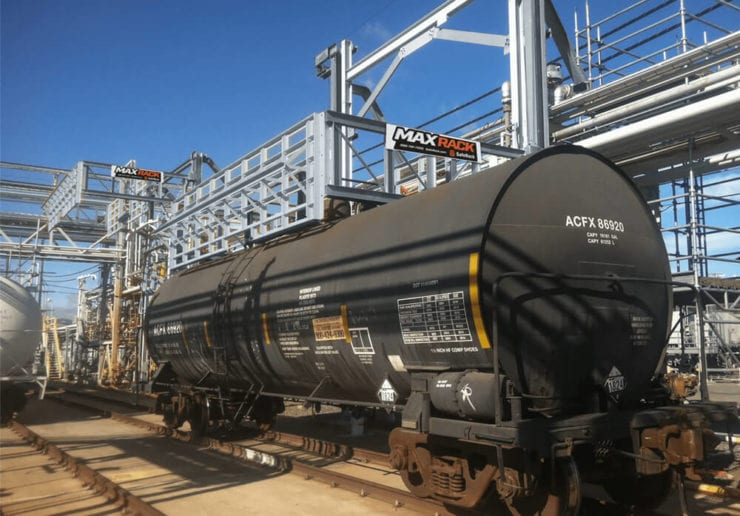


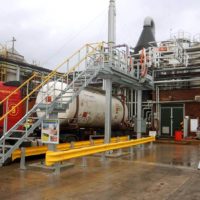
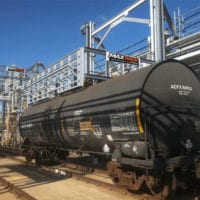
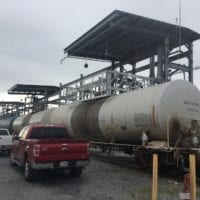
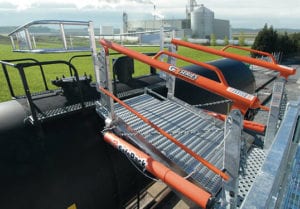
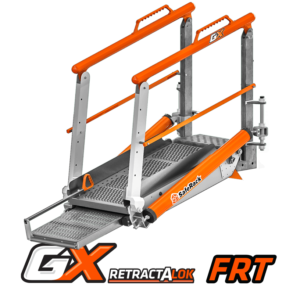
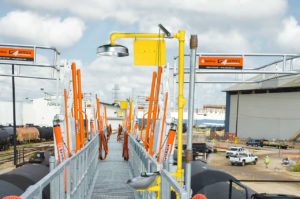
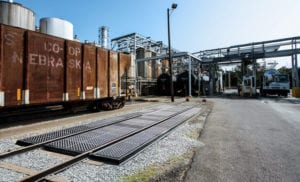
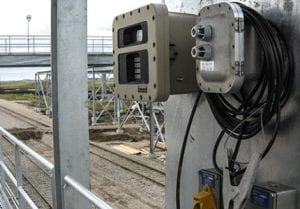
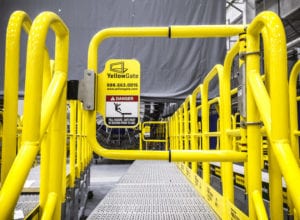
 YellowGate Safety Gates
YellowGate Safety Gates